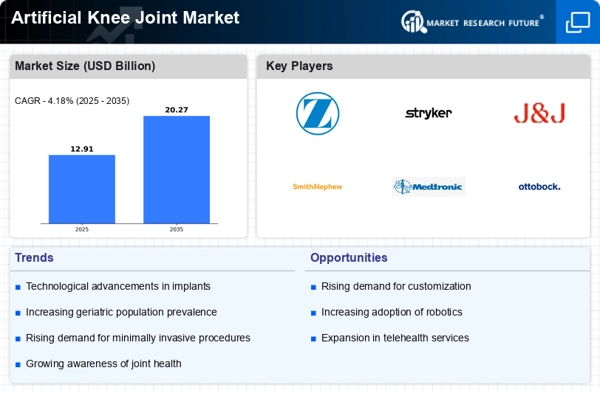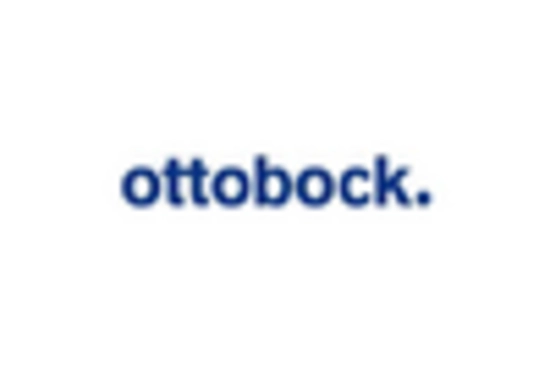Rising Healthcare Expenditure
The upward trend in healthcare expenditure is another significant driver for the Artificial Knee Joint Market. As countries invest more in healthcare infrastructure and services, the availability of advanced medical technologies, including artificial knee joints, increases. Data indicates that healthcare spending is projected to rise by 5.4% annually, with a notable portion allocated to orthopedic procedures. This financial commitment enables hospitals and clinics to adopt cutting-edge knee replacement technologies, enhancing surgical precision and patient recovery times. As a result, the Artificial Knee Joint Market is likely to benefit from this increased investment, leading to improved access to innovative treatment options for patients.
Increasing Geriatric Population
The demographic shift towards an aging population is a crucial factor propelling the Artificial Knee Joint Market. As life expectancy rises, the number of elderly individuals requiring knee replacements is expected to surge. By 2050, it is estimated that the number of people aged 65 and older will reach 1.5 billion globally. This demographic trend creates a substantial market opportunity for artificial knee joint manufacturers, as older adults are more susceptible to degenerative joint diseases. Consequently, healthcare providers are increasingly focusing on developing tailored solutions that cater to the unique needs of this population, thereby stimulating growth in the Artificial Knee Joint Market.
Rising Incidence of Osteoarthritis
The increasing prevalence of osteoarthritis is a primary driver for the Artificial Knee Joint Market. As populations age, the incidence of knee-related ailments rises, leading to a greater demand for knee replacement surgeries. According to recent data, osteoarthritis affects millions worldwide, with projections indicating that by 2030, nearly 67 million adults in the United States alone will be diagnosed with this condition. This growing patient population necessitates innovative solutions in the Artificial Knee Joint Market, as healthcare providers seek to improve patient outcomes and enhance mobility. Furthermore, the economic burden associated with osteoarthritis treatment is substantial, prompting healthcare systems to invest in advanced knee joint technologies that can alleviate pain and restore function.
Technological Innovations in Prosthetics
Technological advancements in prosthetic design and materials are significantly influencing the Artificial Knee Joint Market. Innovations such as computer-assisted surgery, robotics, and smart materials are enhancing the performance and longevity of artificial knee joints. For instance, the introduction of modular knee systems allows for customization based on individual patient anatomy and activity levels. Market data suggests that the adoption of these advanced technologies is expected to grow, with a compound annual growth rate of over 5% anticipated in the coming years. This trend not only improves surgical outcomes but also increases patient satisfaction, thereby driving demand within the Artificial Knee Joint Market.
Growing Awareness and Acceptance of Joint Replacement
There is a notable increase in awareness and acceptance of joint replacement surgeries among patients, which is positively impacting the Artificial Knee Joint Market. Educational campaigns and improved access to information have empowered patients to seek surgical interventions for knee pain and mobility issues. Market Research Future indicates that patient willingness to undergo knee replacement procedures has risen, with many viewing them as viable solutions to regain quality of life. This shift in perception is further supported by endorsements from healthcare professionals, who advocate for the benefits of artificial knee joints. Consequently, the growing acceptance of these procedures is expected to drive demand within the Artificial Knee Joint Market.

















Leave a Comment